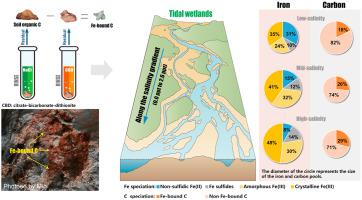Soil Biology and Biochemistry ( IF 9.7 ) Pub Date : 2021-01-04 , DOI: 10.1016/j.soilbio.2020.108128 Jing Bai , Min Luo , Yang Yang , Shuyao Xiao , Zhifeng Zhai , Jiafang Huang

|
Globally, a vast extent of tidal wetlands will be threatened by sea-level-rise-induced salinization. Because ferric (hydro)oxides [Fe(III)] play a crucial role in soil organic carbon (SOC) preservation, understanding the responses of the Fe-bound C pool to increasing salinity could assist in accurate prediction of the changes in C stocks in the tidal wetland soils facing imminent sea-level rise. In this study, we investigated pools of Fe-bound C and SOC, C-degrading enzyme activity, Fe species contents and Fe-cycling bacteria, and plant properties along a salinity gradient from freshwater (0.0 ± 0.1 ppt; part per thousand) to oligohaline (2.6 ± 0.6 ppt) in a subtropical tidal wetland. Overall, the belowground biomass and the content of root Fe(III) plaque (a proxy of root oxygen loss potential) rose with the increasing salinity. Along the salinity gradient, the abundance of Gallionella (Fe-oxidizing bacteria) increased, but the abundance of Geobacter (Fe-reducing bacteria) decreased. The Fe(II):Fe(III) ratios decreased as salinity increased, implying that more Fe(II) was oxidized and immobilized into Fe(III) closer to the sea. Fe sulfides contents also elevated close to sea. The co-existence of Fe(III) and Fe sulfides at the oligohaline sites implied a high spatial heterogeneity of Fe distribution. During the growing season, the SOC pool generally decreased with increasing salinity, probably due to a reduction in aboveground-C input and enhanced activity of the C-degrading enzyme. The Fe-bound C pool was positively affected by the amorphous Fe(III) content and negatively related to the activity of phenol oxidase. The Fe-bound C pool generally rose along the salinity gradient, with the importance of Fe-bound C to SOC increasing from 18% to 29%. Altogether, our findings implied that when the imminent sea-level-rise-induced salinization occurs, the total soil C stock may generally decrease, but Fe-bound C will become increasingly important in protecting the rest of the C stocks in tidal wetland soils.
中文翻译:

在亚热带潮汐湿地中,铁结合碳沿淡水-盐度梯度增加
在全球范围内,海平面上升引起的盐碱化将威胁到大量的潮汐湿地。由于(氢)氧化铁[Fe(III)]在土壤有机碳(SOC)的保存中起着至关重要的作用,因此了解Fe结合的碳库对增加盐度的响应可能有助于准确预测土壤中碳库的变化。即将到来的海平面上升潮汐湿地土壤。在这项研究中,我们调查了从淡水(0.0±0.1 ppt;千分之几)到盐度梯度的铁结合碳和SOC池,碳降解酶活性,铁物种含量和铁循环细菌以及植物特性沿盐度梯度的变化。亚热带潮汐湿地中的oligohaline(2.6±0.6 ppt)。总体而言,地下生物量和根系Fe(III)斑块(根系失氧势的代表)的含量随着盐度的增加而增加。没食子菌(铁氧化细菌)增加,但丰富的土杆菌(减少铁的细菌)减少。Fe(II):Fe(III)的比例随着盐度的增加而降低,这意味着更多的Fe(II)被氧化并固定在离海更近的Fe(III)中。靠近海边的硫化铁含量也升高。Fe(III)和Fe硫化物在寡盐位点处共存,表明Fe分布具有很高的空间异质性。在生长季节,SOC池通常随着盐度的增加而减少,这可能是由于地上C输入减少和C降解酶活性增强所致。Fe结合的碳库受非晶态Fe(III)含量的正影响,与酚氧化酶的活性负相关。结合铁的碳库通常沿盐度梯度上升,结合铁的碳对SOC的重要性从18%增加到29%。共,


























 京公网安备 11010802027423号
京公网安备 11010802027423号